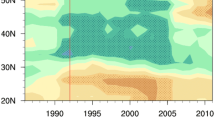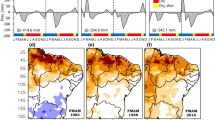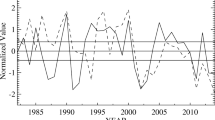Abstract
In austral summer, the observed El Niño (EN) events during warm Pacific Decadal Oscillation (PDO) phases (PDO(+)) exhibited large anomalous upper level wave patterns in response to larger Sea Surface Temperature (SST) anomalies in the Equatorial Pacific and Atlantic Oceans compared with SST anomalies in EN events during cold PDO phases (PDO(−)). The precipitation anomalies in PDO(+) EN are increased over Southeastern South America (SESA) associated with the intensification of the moisture flux convergence in this region. The PDO(−) EN events exhibit positive precipitation anomalies only over southern SESA, while negative anomalies were observed in the north. Downward motion and anomalous divergence over central eastern Brazil may have contributed to the weakening of the northwesterly moisture flux convergence associated with the South American Low Level Jet (SALLJ) over the subtropics. The extratropical cyclones showed higher frequency and lower central pressures in southern Brazil, Uruguay, northeastern Argentina, and Southwest Atlantic Ocean during the PDO(+) EN events compared with the PDO(−) EN events. Such increase in the frequency and intensity of cyclogenesis cases seems to be in accordance with the anomalous moisture flux convergence over the SESA and associated reduction in the Sea Level Pressure observed during PDO(+) EN events. In order to investigate the impact of a canonical El Niño event over South America under different PDO phases, two numerical experiments were done with an Atmospheric General Circulation Model. Global SST and ice sea fields average over years characterized by (a) PDO(+) and (b) PDO(−) were considered as climatologically fields, and a composite of anomalies of SST of all El Niño events observed in 1950–1999 was added in the region 20ºS–20ºN;120ºW–175ºW of both “climatologies.” The differences in experiments suggest that a canonical EN may produce significant different anomalous atmospheric patterns associated with distinct PDO climatologies. The more significant differences are simulated over extreme northern and eastern Brazil. Additional numerical experiments isolating the observed variability of SST over several oceanic basins during different PDO phases will be conducted to study their particular role on the South American climate.






Similar content being viewed by others
References
Ambrizzi T, Souza EB, Pulwarty RS (2004) The Hadley and walker regional circulations and associated ENSO impacts on South American seasonal rainfall. In: Diaz HF, Bradley RS (eds) The Hadley circulation: present, past and future. Kluwer Publishers 7:203–235
Andreoli RV, Kayano MT (2005) ENSO-related rainfall anomalies in South America and associated circulation features during warm and cold Pacific Decadal Oscillation regimes. Int J Climatol 25:2017–2030. doi:10.1002/joc.1222
Berbery EH, Barros VR (2002) The hydrological cycle of the La Plata Basin in South America. J Hydrometeorol 3:630–645
Carvalho LMV, Jones C, Liebmann B (2004) The South Atlantic convergence zone: intensity, form, persistence, and relationships with intraseasonal to interannual activity and extreme rainfall. J Climate 17:88–108
Carvalho LMV, Jones C, Ambrizzi T (2005) Opposite phases of the Antarctic oscillation and relationships with intraseasonal to interannual activity in the tropics during the austral summer. J Climate 18:702–718. doi:10.1175/JCLI-3284.1
Chan S, Behera S, Yamagata T (2008) Indian Ocean dipole influence on South American rainfall. Geophys Res Lett 35(14):L14S12
Chen M, Xie P, Janowiak JE, Arkin EPA (2002) Global land precipitation: a 50-yr monthly analysis based on gauge observations. J Hydrometeorol 3(3):249–266
Collins WD, Rasch PJ, Boville BA, Hack JJ, Mccaa JR, Williamson DL, Briegleb B, Bitz C, Lin SJ, Zhang M (2006) The formulation and atmospheric simulation of the community atmosphere model: CAM3. J Climate 19(11):2144–2161. doi:10.1175/JCLI3760.1
Dettinger MD, Battisti DS, Garreaud RD Jr, Mccabe GJ, Bitz CM (2001) Interhemispheric effects of interannual and decadal ENSOlike climate variations on the Americas. In: Markgraf V (ed) Interhemispheric climate linkages. Academic, San Diego, pp 1–16
Douglas MW, Peña M, Villarpando R (2000) Special observations of the low level flow over eastern Bolivia during the1999 atmospheric mesoscale campaign. Extended Abstracts of the 6th International Conference on Southern Hemisphere Meteorology and Oceanography. Santiago, Chile
Drumond ARM, Ambrizzi T (2005) The role of SST on the South American atmospheric circulation during January, February and March 2001. Climate Dyn 24:781–791
Enfield DB, Mestas-Nuñez A (1999) Multiscale variabilities in global sea surface temperatures and their relationships with tropospheric climate patterns. J Climate 12:2719–2733
Folland CK, Renwick JA, Salinger MJ, Mullan AB (2002) Relative influences of the IPO and ENSO on the South Pacific convergence zone. Geophys Res Lett 29(13):10.1029
Gan MA, Rao VB (1991) Surface cyclogeneses over South America. Mon Weather Rev 119:1293–1302
Garcia SR, Kayano MT (2006) South American Monsoon during the two phases of The Pacific Decadal Oscillation. Proceedings of 8 ICSHMO 1049–1055. Foz do Iguaçu, Brazil
Herdies DL, Da Silva A, Silva Dias MA, Ferreira RN (2002) Moisture budget of the bimodal pattern of the summer circulation over South America. J Geophys Res 107:8075–8084
Kalnay E, Kanamitsu M, Kistler R, Collins W, Deaven D, Gandin L, Iredell M, Saha S, White G, Woollen J, Zhu Y, Chelliah M, Ebisuzaki W, Higgins W, Janoviak J, Mo KC, Ropelewski C, Wang J, Leetmaa A, Reynolds R, Roy J, Joseph D (1996) The NCEP/NCAR 40-year reanalysis project. Bull Am Meteorol Soc 77(3):437–471
Karoly DJ (1989) Southern hemisphere circulation features associated with El Niño–Southern Oscillation events. J Climate 2:1239–1252
Kayano MT, Andreoli RV (2007) Relations of South American summer rainfall interannual variations with the Pacific Decadal Oscillation. Int J Climatol 27:531–540
Kiladis GN, Mo KC (1998) Interannual and intraseasonal variability in the Southern Hemisphere. Meteorology of the Southern Hemisphere, Meteor Monogr 49, Amer Meteor Soc 307–336
Magaña V, Ambrizzi T (2005) Dynamics of subtropical vertical motions over the Americas during El Niño boreal winters. Atmósfera 18(4):211–233
Mantua NJ, Hare SR, Zhang Y, Wallace JM, Francis RCA (1997) Pacific interdecadal climate oscillation with impacts on salmon production. Bull Am Meteorol Soc 78:1069–1079
Marengo J (2004) Interdecadal and long term rainfall variability in the Amazon basin. Theor Appl Climatol 78:79–96
Marengo JA, Soares WR, Saulo C, Nicolini M (2004) Climatology of the Low-Level Jet east of the Andes as derived from the NCEP reanalyses. J Climate 17:2261–2280
Mendes D, Souza EP, Trigo IF, Miranda PMA (2007) On precursors of South American cyclogeneses. Tellus Ser A 59(1):114–121. doi:10.1111/j.1600-0870.2006.00215.x
Mo KC, Paegle JN (2001) The Pacific-South American modes and their downstream effects. Int J Climatol 21:1211–1229
Murray RJ, Simmonds I (1991a) A numerical scheme for tracking cyclone centers from digital data. Part I: development and operation of the scheme. Aust Meteorol Mag 39:155–166
Murray RJ, Simmonds I (1991b) A numerical scheme for tracking cyclone centres from digital data. Part II: application to January and July general circulation model simulations. Aust Meteorol Mag 39:167–180
Newman M, Compo GP, Alexander MA (2003) ENSO-forced variability of the Pacific decadal oscillation. J Climate 16:3853–3857
Oleson KW, Dai Y, Bonan GB, Bosilovich M, Dickinson R, Dirmeyer P, Hoffman F, Houser P, Levis S, Niu G-Y, Thornton P, Vertenstein M, Yang Z-L, Zeng X (2004) Technical description of the Community Land Model (CLM) Technical Report NCAR/TN-461+STR, National Center for Atmospheric Research, Boulder, CO. 80307–3000, p 174
Paegle J (1998) A comparative review of South American low level jets. Meteorologica 3:73–82
Parker DE, Folland CK, Jackson M (1995) Marine surface temperature: observed variations and data requirements. Clim Change 31:559–600
Pezza AB, Ambrizzi T (2003) Variability of southern hemisphere cyclone and anticyclone behavior: further analysis. J Climate 16(7):1075–1083
Pezza A, Simmonds I, Renwick J (2007) Southern hemisphere cyclones and anticyclones: recent trends and links with decadal variability in the Pacific Ocean. Int J Climatol 27:1403–1419. doi:10.1002/joc.1477
Power S, Colman R (2006) Multi-year predictability in a coupled general circulation model. Climate Dyn 26:247–272
Power SB, Smith IN (2007) Weakening of the walker circulation and apparent dominance of El Niño both reach record levels, but has ENSO really changed? Geophys Res Lett 34:L18702. doi:10.1029/2007GL030854
Power S, Casey T, Folland C, Colman A, Mehta V (1999) Interdecadal modulation of the impact of ENSO on Australia. Climate Dyn 15:319–324
Power S, Haylock M, Colman R, Wang X (2006) The predictability of interdecadal changes in ENSO activity and ENSO teleconnections. J Climate 19:4755–4771
Rayner NA, Parker DE, Horton EB, Folland CK, Alexander LV, Rowell DP, Kent EC, Kaplan A (2003) Global analyses of sea surface temperature, sea ice, and night marine air temperature since the late nineteenth century. J Geophys Res 108(D14):4407. doi:10.1029/2002JD002670
Reboita MS; Ambrizzi T; da Rocha RP (2009) Relationship between the southern annular mode and southern hemisphere atmospheric systems. Brazilian Journal of Meteorology 24(1). doi:10.1590/S0102-77862009000100005
Robertson AW, Mechoso CR (2000) Interannual and interdecadal variability of the South Atlantic convergence zone. Mon Weather Rev 128:2947–2957
Saji NH, Ambrizzi T, Ferraz SET (2005) Indian Ocean Dipole events and austral surface air temperature anomalies. Dyn Atmos Ocean 39:87–101
Saulo AC, Nicolini M, Chou SC (2000) Model characterization of the South American low-level flow during the 1997–1998 spring–summer season. Clim Dyn 16:867–881
Schneider N (2005) The forcing of the pacific decadal oscillation. J Clim 18:4355–4373. doi:10.1175/JCLI3527.1
Servain J (1991) Simple climatic indices for the tropical Atlantic Ocean and some applications. J Geophys Res 96:15137–15146
Silva GAM, Ambrizzi T (2006) Inter-El Niño variability and its impact on the South American low-level jet east of the Andes during austral summer—two case studies. Advans Geosci 6:283–287, SRef-ID: 1680- 7359/adgeo/2006-6-283
Silva GAM, Ambrizzi T (2009) Summertime moisture transport over Southeastern South America and extratropical cyclones behavior during inter-El Niño events. Theor Appl Climatol. doi:10.1007/s00704-009-0218-6
Silva GAM, Ambrizzi T, Marengo JA (2009) Observational evidences on the modulation of the South American Low Level Jet east of the Andes according the ENSO variability. Ann Geophyc 27:645–665
Silvestri G (2004) El Niño signal variability in the precipitation over southeastern South America during austral summer. Geophys Res Lett 31:L18206. doi:10.1029=2004GL020590
Smith TM, Reynolds RW, Livezey RE, Stokes DC (1996) Reconstruction of historical sea surface temperatures using empirical orthogonal functions. J Climate 9:1403–1420
Vera C, Silvestri G, Barros V, Carril A (2004) Differences in El Niño response over the Southern Hemisphere. J Climate 17:1741–1753
Wilks DS (1995) Statistical methods in the atmospheric sciences. Academic, NY, p 468
Zebiak SE (1993) Air-sea interactions in the equatorial Atlantic region. J Climate 6:1567–1586
Zhang Y, Wallace JM, Battisti D (1997) ENSO-like interdecadal variability: 1900–93. J Climate 10:1004–1020
Zhou J, Lau KM (2001) Principal modes of interannual and decadal variability of summer rainfall over South America. Int J Climatol 21:1623–1644. doi:10.1002/joc.700
Zhou YP, Higgins RW, Kim H-K (2001) Relationships between El Niño-Southern Oscillation and the Arctic Oscillation: a Climate-Weather Link. NCEP/Climate Prediction Center Atlas 8 [Available online at http://www.cpc.ncep.noaa.gov/products/outreach/atlas.shtml]
Acknowledgments
We thank the editor and the constructive comments of the anonymous reviewers. We also thank M. Chen and collaborators for providing rainfall data and the Climate Prediction Center (CPC/NCEP/NWS) and UK Meteorological Office Hadley Centre for providing the datasets. This work was supported by “Fundação de Amparo à Pesquisa do Estado de São Paulo” (FAPESP 05/01804-0). AD acknowledges the support from FAPESP, from CNPq, and from the Spanish Ministry from Science and Innovation. TA acknowledges the partial support from CNPq/INCT of Climate Change, CAPES, and he has also received funding from the European Community’s Seventh Framework Programme (FP7/2007-2013) under Grant Agreement No. 212492 (CLARIS LPB. A Europe-South America Network for Climate Change Assessment and Impact Studies in La Plata Basin).
Author information
Authors and Affiliations
Corresponding author
Rights and permissions
About this article
Cite this article
Silva, G.A.M., Drumond, A. & Ambrizzi, T. The impact of El Niño on South American summer climate during different phases of the Pacific Decadal Oscillation. Theor Appl Climatol 106, 307–319 (2011). https://doi.org/10.1007/s00704-011-0427-7
Received:
Accepted:
Published:
Issue Date:
DOI: https://doi.org/10.1007/s00704-011-0427-7




